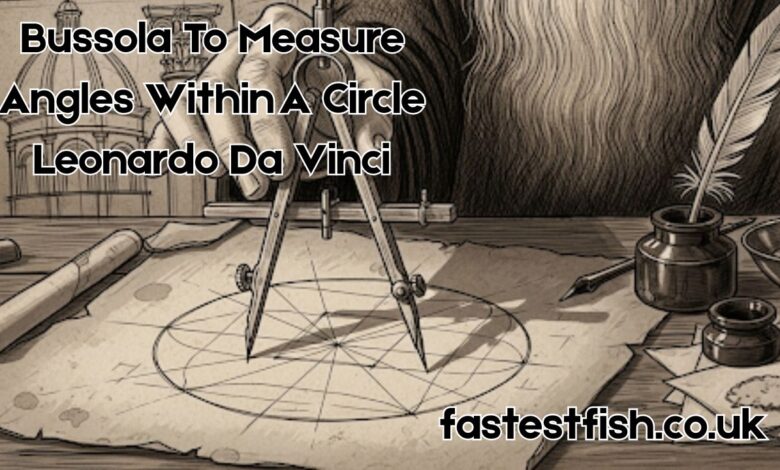Bussola To Measure Angles Within A Circle Leonardo Da Vinci: A Genius Tool Rediscovered

Introduction to the bussola to measure angles within a circle leonardo da vinci
Few names evoke the fusion of art, science, and innovation like Leonardo da Vinci. Among his lesser-known but profoundly insightful instruments lies the bussola to measure angles within a circle leonardo da vinci—a device designed not merely for function, but for exploring the very principles of geometry and proportion. Though often overshadowed by his anatomical sketches or flying machines, this bussola showcases the pure genius of da Vinci’s mathematical mind.
A Historical Glimpse into Renaissance Ingenuity
During the Renaissance, mathematics and geometry were not abstract disciplines—they were tools of discovery. The bussola to measure angles within a circle leonardo da vinci is believed to be part of this tradition, enabling artists, architects, and scientists to measure circular angles with greater precision. While modern protractors are standard today, da Vinci’s approach was revolutionary for its time, combining elegance, usability, and mechanical logic.
What Exactly Is the Bussola?
The word bussola refers to a compass, not in the directional sense, but as an instrument of measurement. The bussola to measure angles within a circle leonardo da vinci is typically visualized as a rotating arm fixed at the center of a circular plate. The device would be calibrated with angle notations along the perimeter, allowing for the accurate division and analysis of arcs and sectors. Though designs varied, the core function remained consistent: to measure angles cleanly within a perfect or imperfect circle.
Leonardo da Vinci’s Obsession with Circles
To fully appreciate the bussola to measure angles within a circle leonardo da vinci, one must understand da Vinci’s obsession with circles. Circles represented perfection, symmetry, and unity in his works. From Vitruvian proportions to mechanical gears and celestial charts, da Vinci saw circles as the divine geometry of the natural world. The bussola was his way of dissecting that perfection—not to dismantle it, but to understand it more deeply.
Artistic Applications of the Bussola
The bussola to measure angles within a circle leonardo da vinci wasn’t limited to mathematics. Da Vinci likely used it when constructing geometrically precise compositions in his paintings and sketches. The tool allowed him to divide a canvas or circular motif into harmonized sectors, essential for creating symmetry in art. From the placement of limbs in the Vitruvian Man to architectural design plans, the bussola played a subtle yet powerful role.
Engineering and the Circle
In mechanical design, angular precision is crucial. The bussola to measure angles within a circle leonardo da vinci would have been indispensable in plotting gears, pulleys, and rotating mechanisms. His notebooks are filled with sketches of circular components—spirals, cams, wheels—all requiring consistent and exact measurements. The bussola was a bridge between concept and execution.
Mathematical Precision in a Manual Age
Before digital instruments and calculators, innovators like da Vinci relied on tools like the bussola to measure angles within a circle leonardo da vinci. It offered a tactile, visual way to study degrees, arcs, and geometric relationships. Its importance lies not only in its function but in how it made mathematical ideas accessible through physical manipulation and visual clarity.
Educational Uses: Teaching Geometry through Instruments
Educators during the Renaissance often used hands-on tools to demonstrate abstract mathematical ideas. The bussola to measure angles within a circle leonardo da vinci would have been a prime educational aid. By rotating the arm and observing angle differences, students could grasp the logic behind sectors, chords, and radian-based measurements. Its value as a teaching device was immense.
The Fusion of Art and Geometry
Leonardo da Vinci believed that art and science were two sides of the same coin. The bussola to measure angles within a circle leonardo da vinci exemplifies this idea. It allowed him to approach aesthetics with a geometric lens, measuring proportions not by intuition alone, but by absolute angles. This tool was both a scientific instrument and an artist’s companion.
Legacy in Modern Instruments
Though rarely credited by name, the spirit of the bussola to measure angles within a circle leonardo da vinci lives on in modern protractors, drafting compasses, and engineering tools. Every circular gauge or mechanical angle measurement device owes something to the conceptual lineage of Leonardo’s bussola.
Exploring the Mind Behind the Tool
Leonardo’s mind was never content with surface answers. With the bussola to measure angles within a circle leonardo da vinci, he not only crafted a tool for accuracy—he created a window into understanding how circular motion and symmetry govern both manmade and natural systems. His inventions reflect a philosophy of learning through building.
Reconstructed Models in Museums
Several reconstructions of the bussola to measure angles within a circle leonardo da vinci exist today in science and history museums. These models, built from da Vinci’s sketches, allow modern viewers to interact with the same concepts that fascinated the Renaissance master. Handling one offers insight into the mind that saw mathematics as an extension of divine order.
Practical Experiments Using the Bussola Today
Modern educators and researchers often create simplified versions of the bussola to measure angles within a circle leonardo da vinci to demonstrate the principles of angular measurement. Using cardboard, pins, and rulers, even students can replicate this tool and explore how early scientific instruments functioned.
Geometry in Motion
One of the greatest insights behind the bussola to measure angles within a circle leonardo da vinci is the relationship between static form and dynamic motion. Circles are not just shapes—they’re systems of rotation, symmetry, and change. The bussola helps break that motion into measurable segments, giving order to the continuous.
Philosophical Implications
Leonardo saw the universe in geometric forms. The bussola to measure angles within a circle leonardo da vinci symbolizes humanity’s attempt to define the infinite. Measuring angles within a circle is, in essence, breaking down the endless into the knowable—a recurring theme in da Vinci’s broader worldview.
From Observation to Innovation
Da Vinci observed nature obsessively. From snail shells to planetary orbits, he saw circles everywhere. The bussola to measure angles within a circle leonardo da vinci was his way of mapping those patterns, turning natural beauty into repeatable systems. It represents the birth of applied geometry.
Influence on Later Inventors
Many Renaissance and post-Renaissance inventors built on Leonardo’s ideas. While the bussola to measure angles within a circle leonardo da vinci may not have been mass-produced, its concept informed a lineage of scientific instruments, influencing cartography, engineering, astronomy, and even early optics.
A Tool of Hidden Significance
Among da Vinci’s hundreds of inventions, the bussola to measure angles within a circle leonardo da vinci may seem minor—but its elegance lies in its simplicity. It’s a reminder that even small tools can carry profound meaning, bridging the gap between abstract theory and tactile understanding.
The Eternal Circle: Final Thoughts
The bussola to measure angles within a circle leonardo da vinci is more than a geometric device—it is a symbol of curiosity, precision, and the pursuit of knowledge. In Leonardo’s hands, even the act of measuring an angle became a form of artistic and philosophical exploration. This tool encapsulates the genius of a man who measured not just circles—but the universe itself.



